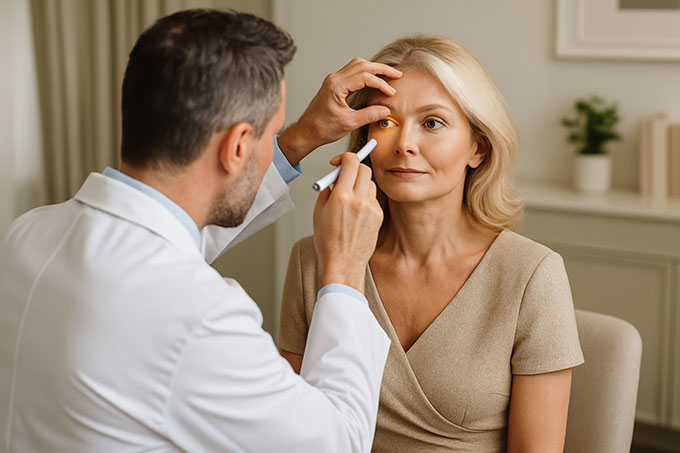Glaucoma, often dubbed the “silent thief of sight,” is a group of eye conditions that damage the optic nerve, leading to irreversible vision loss if untreated. With over 3 million Americans affected and millions more at risk globally, understanding who’s most vulnerable is critical to catching this stealthy disease early. From race and age to medical history and even eye injuries, a range of factors can elevate your risk of developing glaucoma. Here’s what you need to know to stay ahead of this vision-robbing condition.
Race and Ethnicity Play a Role
African Americans face a significantly higher risk of developing glaucoma compared to Caucasians, often experiencing it at younger ages and with greater severity. Studies, like those from the National Eye Institute, show they’re up to five times more likely to develop primary open-angle glaucoma, the most common form, and face a higher chance of permanent vision loss. Hispanic and Asian populations also have elevated risks for specific types, such as angle-closure glaucoma, though the mechanisms differ.
Family History: A Genetic Red Flag
If glaucoma runs in your family, your odds of developing it climb. “A first-degree relative with glaucoma increases your risk four to nine times,” says Dr. Anne Coleman, a glaucoma specialist at UCLA’s Stein Eye Institute. The disease has a genetic component, with certain gene variants linked to optic nerve vulnerability. If your parent or sibling has glaucoma, regular eye exams are non-negotiable.
Age: The Risk Grows with Time
Turning 60 marks a turning point: your risk of glaucoma rises sharply. The prevalence of glaucoma jumps from about 1% in people under 60 to nearly 10% in those over 80, per the American Academy of Ophthalmology. Aging affects the eye’s drainage system, increasing intraocular pressure—a key driver of optic nerve damage.
Medical Conditions Raise the Stakes
Chronic conditions like diabetes, high blood pressure, and heart disease can spell trouble for your eyes. These conditions impair blood flow to the optic nerve or disrupt the eye’s fluid dynamics, creating a perfect storm for glaucoma. For instance, diabetic retinopathy, a complication of diabetes, can trigger neovascular glaucoma, a rare but aggressive form. Regular monitoring of blood sugar and blood pressure is crucial for those at risk.
Eye Injuries and Structural Factors
A hard hit to the eye—think sports accidents or car crashes—can cause immediate spikes in eye pressure or long-term damage to the eye’s drainage system, paving the way for glaucoma. Even subtler factors, like a thinner-than-average cornea or an optic nerve that looks “off” during an exam, can signal heightened risk. Conditions like retinal detachment, eye tumors, or chronic inflammation (uveitis) can also induce secondary glaucoma by clogging drainage pathways or scarring tissue.
Corticosteroids: A Double-Edged Sword
Long-term use of corticosteroids, whether in eye drops, pills, or inhalers, can raise eye pressure, potentially triggering secondary glaucoma. This risk is especially high for those already predisposed. “Patients on chronic steroids need regular eye pressure checks,” advises Dr. Louis Pasquale, a glaucoma expert at Mount Sinai. Switching to alternative treatments or closely monitoring use can mitigate this risk.
Nearsightedness and Other Eye Quirks
Severe nearsightedness (myopia) may increase susceptibility to glaucoma, as elongated eyeballs can strain the optic nerve. While the link isn’t fully understood, studies in Ophthalmology suggest highly nearsighted individuals should be vigilant. Other quirks, like a narrow drainage angle in the eye, can also predispose you to acute angle-closure glaucoma, a medical emergency marked by sudden pain and vision loss.
Why It Matters—and What You Can Do
Glaucoma often creeps up without symptoms until significant vision is lost, making early detection through routine eye exams critical. “Anyone over 40, especially with risk factors, should get a comprehensive eye exam every one to two years,” says Dr. Coleman. Those at higher risk—African Americans, older adults, or those with family history—may need annual checks. Lifestyle tweaks, like managing blood pressure and avoiding smoking, can also support eye health.
The good news? Advances in diagnostics, like optical coherence tomography (OCT), and treatments, from eye drops to minimally invasive surgeries, are helping catch and manage glaucoma earlier. But awareness is the first step. Knowing your risk factors empowers you to protect your vision before the silent thief strikes.
This article draws on insights from the National Eye Institute, the American Academy of Ophthalmology, and peer-reviewed studies, including those published in Ophthalmology. Additional context was informed by expert interviews and posts on X highlighting public interest in glaucoma awareness. Special thanks to the Glaucoma Research Foundation for their comprehensive risk factor data, which shaped this report.


Glaucoma is a serious condition that can lead to irreversible vision loss if not detected early. It’s concerning how certain groups, like African Americans, face a much higher risk and severity of the disease. Family history and age also play significant roles in increasing the likelihood of developing glaucoma. Regular eye exams are crucial for early detection and management. How can we improve awareness and access to eye care for high-risk populations?